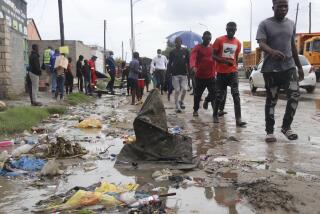Trips Abroad in a Time of Cholera
- Share via
The cholera epidemic ravaging Peru points out the need for an effective vaccine for prevention of the disease that strikes hundreds of thousands in developing countries each year.
A vaccine exists, but the degree and duration of its protection are so minimal that the U.S. Public Health Service does not recommend it for use by travelers visiting areas where cholera is prevalent. Instead, the service advises travelers to observe the usual precautions of eating only well-cooked food, drinking bottled or boiled beverages and, in particular, avoiding raw seafood.
However, several cholera vaccines are in the works that could turn out to be especially useful to residents of cholera countries and may in the future be recommended. One of them may be available by prescription to travelers from Europe in about a year, according to Dr. Myron M. Levine of the University of Maryland’s Center for Vaccine Development.
This and other new vaccines--made by genetic engineering techniques--are taken orally and appear to have a bright future, according to Levine. Several are now in the testing stage and appear to be more effective than the current vaccine, which offers only about 50% protection for up to a few months.
That an effective vaccine is not yet available is not surprising. U.S. public health policy for Third World countries has been to work on preventing environmental conditions that favor disease growth, rather than developing treatment. Cleaning up the environment would be stressed, for example, rather than spending resources to develop a vaccine.
Yet while American travelers are at low risk of acquiring cholera--less than one reported case for every 500,000 returning travelers--the prevalence and severity of the disease worldwide makes it an important health issue.
Cholera is acquired by consuming food or water contaminated with bacteria that cause the disease. The bacteria attach themselves to the lining of the intestines, where they produce a powerful toxin that leads to severe diarrhea.
The vaccine currently available is made of inactivated cholera bacteria, which cannot cause disease. Administered by injection, the vaccine causes the body to make antibodies against the live cholera bacteria. But the protection by the antibodies circulating in the bloodstream is poor because they cannot easily reach the bacteria on the surface of the intestinal lining.
The Peruvian epidemic--the first to hit South America during this century--has left health officials in other South American countries with the worrisome prospect of a South American epidemic. Already cases are being reported in neighboring Ecuador.
There is good reason for concern. Cholera can quickly run rampant in places where sanitation is inadequate. In the 1970s, a major epidemic spread from country to country in North, East and West Africa. The disease also reached up into Portugal and Italy, where higher hygienic standards finally stopped the epidemic in its path. Nevertheless, health officials were disturbed by the appearance of cholera in Europe, which had been cholera-free for 50 years.
“The $64-million question now is what will happen in the rest of South America,” said Dr. Robert Tauxe, a medical epidemiologist for the U.S. Centers for Disease Control.
Cholera has long been a major killer in India and nearby countries. But it was not until 1817 and subsequent years that it spread for the first time into the Middle East, Africa, Europe and North and South America. The 1817 epidemic was the first of six worldwide epidemics (called pandemics) that erupted in 1826, 1842, 1865, 1881 and 1899.
Following the sixth pandemic--the one that began in 1899 and ended in the 1920s--cholera was largely confined once more to the Indian subcontinent. Then in 1960, a new type of cholera bacteria known as “El Tor” appeared and launched the seventh pandemic, which still is under way. It originated in Indonesia and since has spread and caused epidemics around the world, but bypassed North and South America until January, when it triggered the Peruvian outbreak.
By last week, well over 60,000 cases had been reported, with at least 259 deaths in Peru.
Just as in the old days, the disease spreads along sea coasts and waterways and over land trade routes. In the United States, for example, the 1830s epidemic spread along the coast and the rivers of the northeast. After the building of the railroads, the 1860s epidemic spread quickly along railways to the largest cities inland.
Nobody knows how El Tor got to Peru, but it probably was transported by ship or airplane passengers, possibly from Asia. The bacteria can be transported by human carriers who themselves may not be ill. If sewage and water purification systems are inadequate, the El Tor bacteria can grow in many kinds of food and spread quickly to large populations. In Peru, raw fish is the chief source of the infection.
When the profuse watery diarrhea and vomiting associated with cholera are not treated early, patients can die of dehydration within hours. The chief treatment is to rehydrate patients orally or intravenously with salt-sugar solutions, which can reduce the mortality rate from 50% to 2%.
According to the World Health Organization, parts of 26 nations, ranging from Algeria to Zambia, are currently infected with quarantinable cholera. No country requires cholera vaccination for direct travel from the United States, and no vaccinations are required to return to the United States.
To find out if a country is infected with cholera, call the International Traveler’s Hotline at the Centers for Disease Control in Atlanta: (404) 639-2572.
More to Read
Sign up for Essential California
The most important California stories and recommendations in your inbox every morning.
You may occasionally receive promotional content from the Los Angeles Times.













